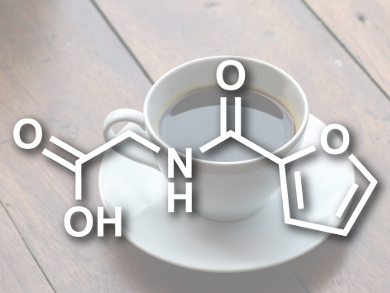Coffee is the second-most consumed beverage in the world, after water. Detailed examinations of coffee’s bioactive ingredients require a more accurate accounting of test subjects’ consumption habits than is feasible using food diaries.
Silke Heinzmann, Helmholtz Zentrum München, Neuherberg, Germany, and colleagues identified 2-furoylglycine (pictured) as a coffee-specific biomarker compound, which distinguishes it from other biomarkers reported to date. They found this marker using 1H NMR to analyze the urine of subjects participating in a dietary study.
The study was small, involving eight volunteers who ate standardized meals and donated urine samples throughout the day over the course of one week. They drank coffee as desired between the hours of 8:00 AM and noon every day, except for the first day. One subject drank chicory coffee, and one drank Earl Grey tea.
To confirm the discovered correlation of 2-furoylglycine with coffee consumption, excretion profiles were monitored for five volunteers. Each volunteer drank one espresso at the start of the study. They donated urine specimens over the course of two days, during which they ate whatever foods they wanted. The researchers note that 2-furoylglycine is produced by the coffee bean roasting procedure, and it is not present in other beverages.
- 2-Furoylglycine as a Candidate Biomarker of Coffee Consumption,
Silke S. Heinzmann, Elaine Holmes, Sunil Kochhar, Jeremy K. Nicholson, Philippe Schmitt-Kopplin,
J. Agric. Food Chem. 2015.
DOI: 10.1021/acs.jafc.5b03040
Also of interest
- Coffee Fascinates Chemists,
Vera Koester,
ChemViews Mag. 2015.
DOI: 10.1002/chemv.201500048


